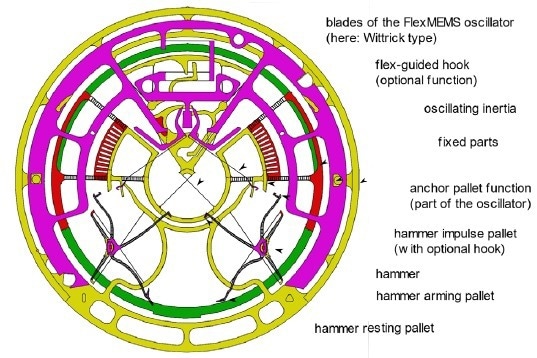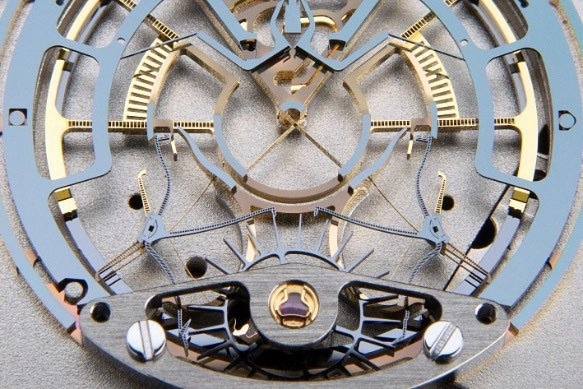Sponsored by CSEMReviewed by Olivia FrostOct 20 2022
With its combined knowledge of micro-manufacturing processes and accuracy processes, CSEM has been a pioneer in the design and production of centimeter-scale silicon parts with fine mechanical features that include flexures (FlexMEMS), creating new possibilities for the design and production of novel and groundbreaking watch methods.
The development of brand-new, high-performance watch oscillators and escapements is the main emphasis of CSEM’s SILOSCAPE work. This year, the CSEM displays a brand-new constant force escapement built using the FlexMEMS design methodology.
The constituent parts that make up the core of any watch mechanism, the escapement and the oscillator, are renowned to be small, fragile, and extremely accurately machined.
The use of silicon as a base material for the design and manufacture of mechanical watch parts was pioneered by CSEM toward the end of the 20th century. By using silicon microfabrication methods,1 CSEM designed and produced extremely accurate and thermally compensated silicon watch hairsprings, which are the most important component of the oscillator.
Since then, CSEM has continued to play a leading role by expanding the boundaries of silicon’s micromechanical structure2 and honing its skills in the creation and manufacture of unique watch mechanisms based on this strategy.3,4
FlexMEMS Method
CSEM has developed a new approach for the design and production of novel high-end oscillators and escapements that combines the benefits provided by the accurate micro-structuration of silicon with those of flexure bearings, building on its comprehensive background and knowledge in the design of accuracy methods steered by flexure blades instead of classical bearings.
When lubrication is banned due to the environment (such as vacuum, space) or due to contamination limits, the so-called “FlexMEMS method” is especially helpful (fine optics).
In close collaboration with Vaucher Manufacture Fleurier over the past 15 years, CSEM has suggested numerous novel designs for mechanical watch oscillators5 and incorporated the first-ever FlexMEMS Genequand escapement6 and the first-ever flexure-based watch regulator (escapement + oscillator) at the watch scale.
Since then, CSEM has put forward the Siloscape escapement,7 a revolutionary FlexMEMS escapement with a power reserve that is three times greater than traditional ones and classical precision performance. It is auto-starting by design, so significant accidental shock cannot stop it.
Double Hammer Escapement
The newest FlexMEMS-based escapement created and made by CSEM is the so-called Double Hammer escapement (Figures 1 and 2). This cutting-edge escapement is a constant force escapement that targets extremely accurate timekeeping (usually +/-2 s/d) with a regular power reserve.
Two silicon parts called "hammers" that are pivoted on flexure blades are successively (at each alternance) armed by the escapement wheel, which rotates them at a prescribed angle. To ensure that the possible energy stored in their flexures is sufficient to support the oscillations of a Wittrick-type FlexMEMS oscillator, it stores a certain quantity of energy in their flexure pivot before releasing them.
The oscillator will obtain the same impulse energy at each alternation because, in the range of operation, the prospective energy stored in the hammers is stable and separate from the torque available at the escapement wheel. Maintaining the oscillator’s amplitude as constant as possible during operation will improve the watch’s accuracy in keeping time.

Figure 1. Main constitutive parts of the “Double Hammer”. Image Credit: CSEM (Swiss Center for Electronics and Microtechnology)
The oscillator, which is manufactured as a monolithic silicon part assembled wafer-level, has the equivalents of the traditional anchor impulse pallets integrated directly in it. The oscillator is manually put together from a second monolithic silicon chip that includes two hammers and optional flex-guided hooks.
The disturbances are reduced by using flex-guided hooks to prevent the hammer from touching the oscillator during the resting phase. High power reserve and chronometric outputs are two complementing market sectors that CSEM targets with the “Double Hammer” and Siloscape escapements.

Figure 2. The "Double Hammer" escapement integrated in a watch. Image Credit: CSEM (Swiss Center for Electronics and Microtechnology)
References and Further Reading
- A. Perret, "Le silicium comme matériau dans la fabrication de pièces mécaniques", SSC, 2001.
- O. Dubochet, et al., “ L’hybridation du silicium”, SSC, 2015.
- M. Despont, et al., “Tic-Tac” made in Silicon”, SSC, 2019.
- G. Musy et al., "Les technologies de micro-fabrication et de l’aérospatiale au service de l’innovation horlogère ", SSC 2021.
- F. Barrot, et al., "Flexure based oscillators for mechanical watches CSEM Scientific and Technical Report (2018) 19.
- F. Barrot, et al., “Un nouveau régulateur mécanique pour une réserve de marche exceptionnelle”, SSC, 2014.
- F. Barrot, et al., "A Novel Silicon-based Flextech Watch Escapement", CSEM Scientific and Technical Report (2019) 20.

This information has been sourced, reviewed and adapted from materials provided by CSEM.
For more information on this source, please visit CSEM's expertise on MEMS & Packaging and Scientific Instrumentation.